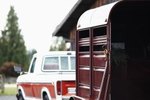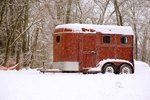
Cross ties serve a function similar to the traditional hitching post. The cross tie design is safer and provides more control than a single post and lead rope do. Regardless of the size of your horses, properly placed and spaced cross ties allow you to tie up your horses safely and securely. The design of your cross ties will make the difference between a functional piece of equipment and a safety hazard in your barn.
Description
Cross ties consist of two separate ropes that stretch out from posts on either side of the horse and attach to the buckles on either side of the noseband of the halter. The anchor posts may be part of the actual structure of the barn or they may be placed independently within the barn. Cross ties limit the horse's range of movement and prevent the horse from becoming tangled around the posts or in the ropes. You can use normal-size cross ties on miniature horses, but they are often either too loose or too tight because they are not placed low enough or sized properly to contain small horses.
Function
Miniature horses use cross ties for the same purpose as their larger counterparts do. The posts should be placed far enough apart to allow room for tack, equipment, farriers, veterinarians and riders to move around the horse and handle the horse comfortably. The horse stands in the center of the cross ties, between the two posts and attached by a rope on either side of his head. Ties can be located in the barn aisle, in stalls, on a wash rack or even outside of the barn altogether. You can set up a pair of cross ties in any area where you have adequate space for the posts, ties and the horse.
Design
Most cross tie posts are spaced between 10 and 12 feet apart. Your cross tie ropes should be long enough to clip the ends of the rope to one another in the center. If your total space is 10 feet wide, your ropes each need to be at least 5 feet but no more than 6. The ideal cross tie rope should be similar to a lead rope. You want a tie that will stretch slightly during use. The fixtures on your cross ties are mostly chosen based on personal preference. Most cross ties feature quick-release buckles that release the horse quickly in case of emergency. The end of the rope that attaches to the post is normally either tied or clipped onto a eye bolt that has been screwed into the top section of the post.
Miniature Horses
The primary difference between a cross tie for large horses and one designed for use on miniature horses is the height at which the ropes are placed on the poles. The ropes typically are 7 feet above the ground for use with normal-size horses. With miniature horses you will want the ropes to be placed approximately 4 feet off the ground. The ties should be fastened to your posts so the part of the tie that is attached to the post is higher than your horse's head. You need to have plenty of room to attach the horse to the ties without the ropes hanging low enough that the horse could get his foot over the tie and become tangled. The horse should have enough slack in the ropes that he can move his head up and down relatively freely and his range of motion is slightly restricted but not severely confined.
References
Photo Credits
-
David De Lossy/Photodisc/Getty Images
Writer Bio
Jen Davis has been writing since 2004. She has served as a newspaper reporter and her freelance articles have appeared in magazines such as "Horses Incorporated," "The Paisley Pony" and "Alabama Living." Davis earned her Bachelor of Arts in communication with a concentration in journalism from Berry College in Rome, Ga.



